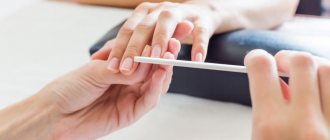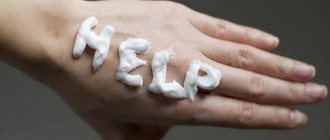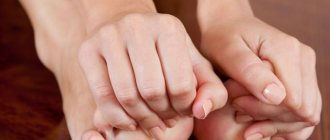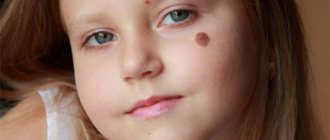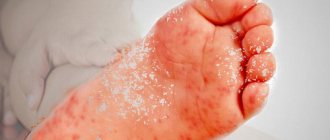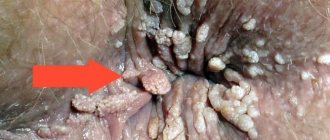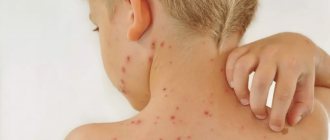Causes of ingrown toenails in children
- Insufficient care - it is necessary to regularly trim the plate evenly, without rounding.
- Lack of vitamins in the diet - deformations of the nail occur, it injures soft tissues.
- The appearance of fungus means the surface becomes uneven, increasing the risk of developing pathology.
- Flat feet - the uniform distribution of the load on the foot is disrupted.
- Rickets - too thin and brittle nails.
- Incorrectly selected shoes are narrow, tight, which compress the foot and lead to ingrown hairs.
- Genetic predisposition - if close relatives have a tendency to ingrown nails, you need to carefully monitor your baby’s nails.
- Trauma - if a child hits or injures a finger, pathology may occur.
Treatment of boils in children
If the child’s boil is small in size and is not located on the face, neck or knee, treatment at home is allowed. In case of extensive lesions or multiple purulent foci, hospitalization is required.
With a relatively mild course of the disease, conservative treatment is sufficient, which depends on the stage of development of the disease:
- at the initial stage, alcohol solutions and dry heat are used to accelerate ripening;
- at the necrotic stage, antibacterial agents, proteolytic drugs and regular wound washing are necessary;
- at the healing stage, agents are used that accelerate regeneration in combination with antibacterial treatment.
In more severe cases, local treatment is supplemented with systemic drugs: antibiotics, anti-inflammatory drugs, immunostimulants, etc. If the infection spreads to adjacent tissues with the development of abscesses or phlegmons, surgical assistance is required: opening and draining the abscess.
Symptoms of the disease
The manifestation of onychocryptosis in children is difficult to detect when the child cannot explain what is bothering him. Mom may notice swelling and redness of the nail fold. If pus is released, you should consult a doctor to treat and treat the affected area. Independent actions can aggravate the problem and lead to the need to remove a child’s ingrown toenail.
Main symptoms:
- pain that gradually increases;
- redness and swelling, if infection occurs, suppuration occurs;
- overgrowth of the affected area with soft tissues;
- increased body temperature as a consequence of the inflammatory process.
Possible causes of an abscess
- A purulent abscess on the finger often occurs due to the habit of biting nails. A child’s teeth damage the skin, allowing pathogenic bacteria to enter the body.
- The finger is festering due to hangnails. Since children's skin is very delicate, even a small defect in the skin near the nail allows dirt to penetrate the body.
- The inflamed area breaks out due to the pliability of the nail plate in infants. If you trim your nails incorrectly or carelessly, you can deform the nail, which can lead to it growing into the skin. This, in turn, leads to tissue inflammation.
READ ALSO: Maculopapular rash - what it looks like in the photo, the first symptoms and how to treat it
Consequences of the problem
It is necessary to consult a doctor in a timely manner so as not to aggravate the situation and not lead to complications. Ingrown toenails come with a risk of infection in the affected area. As a result, suppuration may occur.
In the absence of proper therapy, ingrowth can lead to abscess, osteomyelitis and sepsis. In children, the infection spreads quickly. This is especially dangerous for weakened children with diabetes. Source: I.P. Zhurilo, V.K. Litovka, G.A. Sopov, K.V. Latyshov, I.N. Inozemtsev The problem of ingrown toenails in children // Child's Health, 2012, No. 2(37), pp. 139-141
Doctors take the problem of ingrown toenails seriously and recommend promptly starting therapy and carrying out a set of measures.
Danger of boils
Failure to see a doctor in a timely manner can lead to dire consequences, since this pathology belongs to the category of dangerous diseases:
- a boil on a child’s head can cause meningitis;
- a boil on a child’s lip can cause inflammation of the nerves of the nasolabial triangle;
- a boil on the child’s bottom makes it difficult to sit;
- a boil on a child’s face can lead to meningitis;
- a boil in a child’s nose can cause inflammation of the respiratory system;
- a boil in a child’s ear can cause inflammation of the hearing organ;
- A boil on a child’s neck can lead to inflammation of the lymph nodes and severe intoxication.
In the absence of timely medical care, a carbuncle, which is a collection of boils, may develop. Possible consequences are also:
- infection of the deep layers of skin tissue;
- scar formation after healing;
- sepsis.
The appearance of multiple boils causes discomfort in the child, increased temperature, and deterioration of well-being.
The consequences of the formation of a boil can be prevented if you promptly contact the pediatric department of JSC "Medicine" (clinic of Academician Roitberg), which offers the services of qualified experienced specialists in various fields of medicine.
Our clinic is located in the center of Moscow at the address: 2nd Tverskoy-Yamskaya lane, 10, a five-minute walk from the Mayakovskaya metro station.
Treatment of pathology
What to do if a child has an ingrown toenail and becomes inflamed? It is necessary, without delay, to consult a doctor who will conduct an examination and prescribe adequate treatment.
Parents often do not correctly assess the severity of the problem. Suppuration may not be noticeable. If you take a hot bath or warming procedures, it will only harm your health.
You cannot begin treatment for an ingrown toenail if suppuration is visible on the child’s foot, without consulting a surgeon. Make an appointment with a specialist so that your baby recovers quickly without the risk of complications.
At the first manifestations
The problem doesn't come out of the blue. Already at the first complaint of pain from a child, you need to carefully examine the leg. If you notice that the edge of the nail rests on the roller, which has turned red or white, you need to prepare a warm bath with chamomile or a weak solution of potassium permanganate. Then wipe the area with alcohol. Remove the part of the plate that rests on the soft tissue. Monitor your finger closely until the inflammation goes away. Source: A.B. Baburin, V.I. Loginov, V.V. Parshikov Method of complex treatment of ingrown nails // Medical almanac, 2012, No. 5(24), pp. 228-230
Surgical method
When the problem is serious, accompanied by suppuration and inflammation, they resort to surgery. Doctors remove the edges of a child's ingrown toenail.
Features of the procedure:
- a piece of skin is taken from the pad to stitch the wound, the rollers are moved away from the edges and the nail plate grows straight, in the right direction;
- For children the intervention is performed under general anesthesia, for older children under local anesthesia;
- After the procedure, you must come back for dressing changes twice, follow the care recommendations and wear open-toed shoes;
- the rehabilitation period lasts about a week, complete healing requires 20 days;
- To prevent recurrence of the problem, it is recommended to take baths to steam the finger and carefully move away the skin ridges, giving the nail a rounded shape.
Medication method
The measures are aimed at relieving inflammation and treating without surgery. Prescribed agents for oral and external use. Tamponade is used - placing a material soaked in medicine between the nail and the roller. Ointments effectively relieve inflammation and pain, and draw out pus. If ointments alone are not enough, medications are prescribed for oral administration. Source: https://www.ncbi.nlm.nih.gov/pubmed/30843080 Gera SK, PG Zaini DKH, Wang S, Abdul Rahaman SHB, Chia RF, Lim KBL Ingrowing toenails in children and adolescents: is nail avulsion superior to Nonoperative treatment? // Singapore Med J. 2022 Feb;60(2):94-96. doi: 10.11622/smedj.2018106
How is paronychia treated?
At the stage of conservative treatment, depending on what caused the lesion, the doctor may prescribe antifungal drugs or antibiotics - both local and general, taken orally. Warm lotions are also usually prescribed and applied to the affected area. Levomekol is often prescribed for treatment, which has a good anti-inflammatory effect, including during infection with staphylococcus. Surgical treatment of paronychia is no different from any other purulent inflammation. The abscess is opened, cleaned of purulent contents, the wound cavity is drained, if necessary, and the affected area is disinfected. Until recovery, you will have to change the bandage every day. This procedure is performed under local anesthesia and takes on average 20 minutes. The child may be prescribed antibiotics - local, in the form of an ointment, or for oral administration. During the rehabilitation period, the finger cannot be wet. Therefore, you will have to refuse to visit the pool and sauna. You can swim if the child himself or the adult who helps him can make sure that the finger remains dry.
Disease prevention
To avoid risk, you should follow a number of recommendations:
- be careful when choosing shoes - they should be comfortable, with a round toe, of the appropriate size;
- socks and tights must be of high quality, fit tightly to the foot, and not move down;
- trim your nails correctly with manicure scissors or clippers - so that the edges are smooth and not rounded (do not cut off the corners, but file them).
If you suspect a problem, make an appointment with a specialist at our clinic in St. Petersburg. At the appointment, the doctor will examine the leg, advise how to treat the problem, prescribe medications or recommend surgery.
Sources:
- I.P. Zhurilo, V.K. Litovka, G.A. Sopov, K.V. Latyshov, I.N. Inozemtsev. The problem of ingrown toenails in children // Child's Health, 2012, No. 2(37), pp. 139-141.
- A.B. Baburin, V.I. Loginov, V.V. Parshikov. Method for complex treatment of ingrown toenails // Medical almanac, 2012, No. 5(24), pp. 228-230.
- https://www.ncbi.nlm.nih.gov/pubmed/30843080
Gera SK, PG Zaini DKH, Wang S, Abdul Rahaman SHB, Chia RF, Lim KBL. Ingrowing toenails in children and adolescents: is nail avulsion superior to nonoperative treatment? // Singapore Med J. 2019 Feb;60(2):94-96. doi: 10.11622/smedj.2018106.
Grebenyuk Mikhail Viktorovich Clinic
Author of the article
Grebenyuk Mikhail Viktorovich
Specialty: surgeon
Experience: 19 years
The information in this article is provided for reference purposes and does not replace advice from a qualified professional. Don't self-medicate! At the first signs of illness, you should consult a doctor.
Prices
| Name of service (price list incomplete) | Price |
| Appointment (examination, consultation) with a pediatric surgeon, primary, therapeutic and diagnostic, outpatient | 1950 rub. |
| Consultation (interpretation) with analyzes from third parties | 2250 rub. |
| Prescription of treatment regimen (for up to 1 month) | 1800 rub. |
| Prescription of treatment regimen (for a period of 1 month) | 2700 rub. |
| Consultation with a candidate of medical sciences | 2500 rub. |
| Hernia repair of umbilical hernia/hernia of the white line of the abdomen, category I. difficulties | 33,000 rub. |
| Removal of condylomas, category I. difficulties | 3550 rub. |
| Removal of condylomas, category II. difficulties | 8900 rub. |
| Excision/removal of benign formations of the skin and mucous membrane, category I. difficulties | 2550 rub. |
Treatment of felon
Surgeons treat felons. With superficial forms, the patient may be on an outpatient basis; with deep forms, hospitalization is necessary.
In the early stages, patients with superficial panaritium can be prescribed conservative therapy: darsonval, UHF, thermal procedures.
In the later stages of superficial panaritium, as well as at all stages of the bone and tendon form of the disease, surgery is indicated. The opening of the panaritium is supplemented with drainage so as to ensure the most effective outflow from the fiber divided into cells.
Surgical tactics for bone or joint felon are determined by the degree of preservation of the affected tissues. In case of partial destruction, resection of the damaged areas is performed. In case of total destruction (possible with bone and osteoarticular panaritium), amputation is indicated. In parallel, drug therapy is carried out aimed at combating inflammation (antibiotics), reducing pain and eliminating the phenomena of general intoxication.
